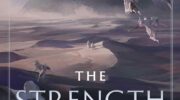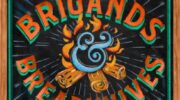Lavishly sensual, sexuality breathes throughout the book, with a humming roar of violence lurking in the background, or sometimes just exploding across the page in a fury.
I will give a strong warning up front (which is a small *spoiler*) that readers should be warned there is an element of romance between an adult male and an underage girl. The romance is of the sort where the male has a soul-like connection to her, and though he does hunger for her, he is (mostly) content to wait for her to come of age. This works for the most part, but will disturb many readers, and there is a time where this convention is somewhat broken.
Seven hundred years ago, a Black Widow witch saw an ancient prophecy come to life in her dazzling web of dreams and visions.
Now the Dark Kingdom readies itself for the arrival of its Queen, a Witch who will wield more power than even the High Lord of Hell himself. But she is still young, still open to influence–and corruption.
Whoever controls the Queen controls the Darkness. Three men, sworn enemies, know this. And they know the power that hides behind the blue eyes of an innocent young girl. And so begins a ruthless game of politics and intrigue, magic and betrayal, where the weapons are hate and love–and the prize could be terrible beyond imagining.
Daughter of the Blood is Book 1 of the Black Jewels trilogy, where there is a Light Realm, Dark Realm, a Twisted Kingdom, and for powerful practitioners of the Craft they can travel through the veil of death itself. There is a struggle in the background, an epic contest that transcends realities, but for now the story centers on the ruler of Hell, a lost son, and a cast of characters raging at their bonds. But the story ends up very personal, very small; there are no epic battles, though the danger often buzzes in the background.
Anne Bishop writes good prose with vivid characters, but I was often left feeling a disconnect from any sense of an actual cohesive story. There seems no direction until nearly halfway through where it strangely enough becomes a story of a “chosen one” coming into their power. But (and this is where it is stands out as different), the story is told by those that exist around them and are influenced by this “chosen one”. An interesting diversion from the norm, I will be curious if this continues into the sequel.
While there are many elements of tension and conflict, many also felt artificial, such as Daemon Sadi—lovingly called “the Sadist”—invited into the homes of powerful aristocrats to pleasure and entertain the high ladies; this, despite a long (and I mean loooong) history of leaving a grisly bloodbath in his wake when pushed too far.
Which is pretty much ALL the time. What can I say, he’s a prickly sort.
While the story eventually finds its path, the main (real) tension of the book remains elusive until near the end where pedestrian parents to this child prodigy (CHOSEN ONE), ignorant of her talent, shunt her into a mental institute — the true nature of which eventually emerges from the rotting surface late in the novel. And suddenly everything in the story comes together: the characters, the plot, the main conflict, and we have an epic quest to free the chosen one from a dastardly doom I can’t relate to you here.
Let’s just say it is really, really bad. (Like, pretty terrible. George R.R. Martin kind of bad.)
Some of the reviewers of the book found the story to be a refreshing reversal of gender roles, and true enough it was, but the reversal felt half done, as did their power. Daemon, though Ringed, and controlled with pain by his ringholder, was nevertheless able to rend and destroy with little consequence. Even his brother, though not as powerful as Daemon, rebels and acts out plenty on his own. The gender reversal didn’t end up appearing positive to me; there was nary a powerful lady that exercised her power fairly.
Despite being a bit scattered as the story started, unsure of who or what the book was about, trying to come to grips with the multiple lands, the characters, I felt it did come together finally and look forward to Book 2 where hopefully the greater focus continues and builds.
© Clifton Hill – Author of the Fantastical and sometimes reviewer.
www.cliftonh.com
March 1998 | Roc | www.annebishop.com






this is one of my favorite series….so rich and full. it was unlike anything i had read before.
It was quite different, for sure. I have books 2 & 3 on my shelf from a friend to read. Now I just need to find the time…